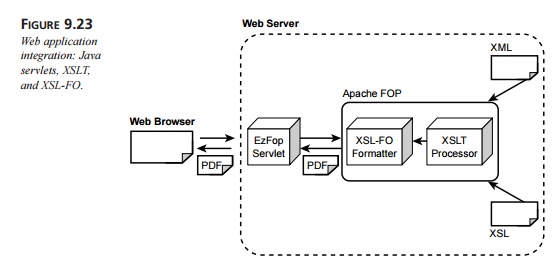Chapter: XML and Web Services : Building XML-Based Applications : Transforming XML with XSL
Web Application Integration: Java Servlets, XSLT, and XSL-FO
Web Application Integration: Java Servlets, XSLT, and XSL-FO
In this section, we will pull all the parts together and develop a Web
application that inte-grates Java servlets, XSLT, and XSL-FO. We will develop a
Java servlet to pass an XML document and XSL style sheet to the Apache-FOP
formatting engine. The XML docu-ment is booklist.xml. The XSL style sheet, booklist_table.xsl, contains the XSL-FO template code to generate a table. The servlet
will respond with the PDF document gen-erated by the Apache-FOP formatting
engine. The application interaction is shown in Figure 9.23.

Developing the Java Servlet
The Java servlet handles an HTTP GET request. The servlet sets up a reference to the files booklist.xml and
booklist_table.xsl. The Apache-FOP API provides
access to the Apache-FOP
formatting engine via the class org.apache.fop.apps.Driver. The follow-ing code creates an instance of the driver and sets the
renderer to PDF:
// setup the driver for PDF Driver driver = new
Driver();
driver.setRenderer(Driver.RENDER_PDF);
Next, the servlet creates a file reference for the XML document and XSL
style sheet. Because the servlet is running in the context of a servlet engine,
we need to retrieve the real path to the Web application’s root (c:\foo\ch9_xsl\xsl_fo\public_html). The XSLTInputHandler class transforms the XML document
using the XSL style sheet, and the
resulting document is input for the Apache-FOP processing engine. This is
accom-plished in the following code fragment:
String appRoot = getServletContext().getRealPath(“/”);
String
xmlFileName = “booklist.xml”;
String xslFileName =
“booklist_table.xsl”;
File
xmlFile = new
File(appRoot + xmlFileName);
File
xslFile = new
File(appRoot + xslFileName);
//
create an input
handler for the
XSLT transformation
XSLTInputHandler inputHandler = new XSLTInputHandler(xmlFile,
xslFile); XMLReader parser = inputHandler.getParser();
Now, we need to set up an output for the XSL-FO formatter process. We’ll
use a ByteArrayOutputStream object to serve as a temporary buffer. The XSL-FO processor generates the PDF document using
the following code:
setup the output
for XSL-FO formatter
process
temporarily place in a ByteArrayOutputStream ByteArrayOutputStream out =
new ByteArrayOutputStream(); driver.setOutputStream(out);
Run the formatter based on the XSL-FO document driver.render(parser,
inputHandler.getInputSource());
Finally, we need to send the PDF document back to the Web browser.
Recall from the previous step that the document was placed in a temporary
buffer. All we have to do is access the content of the temporary buffer and
send the content using the response. This is accomplished in the following
code:
The out object
has the result
of the XSL-FO
formatter process
Retrieve the content
from ByteArray
byte[]
content = out.toByteArray();
Setup the response for the web browser
response.setContentType(“application/pdf”);
response.setContentLength(content.length);
Finally, send the
result to the
browser!
OutputStream outputToBrowser =
response.getOutputStream(); outputToBrowser.write(content);
outputToBrowser.flush();
Listing 9.19 contains the complete code for the EzFopServlet.
LISTING 9.19 <install_dir>\ch9_xsl\xsl_fo\servlet_source\EzFopServlet.java
import java.io.File;
import java.io.OutputStream;
import java.io.ByteArrayOutputStream; import java.io.IOException;
import javax.servlet.ServletException; import
javax.servlet.http.HttpServlet;
import javax.servlet.http.HttpServletRequest; import
javax.servlet.http.HttpServletResponse;
import org.xml.sax.XMLReader;
import org.apache.fop.apps.Driver;
import
org.apache.fop.apps.XSLTInputHandler;
/**
* Example servlet to generate a PDF from an XSL-FO
document */
public class EzFopServlet
extends HttpServlet {
public void
doGet(HttpServletRequest request, HttpServletResponse response) throws
ServletException, IOException {
try {
// get the
application root for
this web app
String appRoot = getServletContext().getRealPath(“/”);
String xmlFileName = “booklist.xml”; String
xslFileName = “booklist_table.xsl”;
File xmlFile = new File(appRoot + xmlFileName);
File xslFile = new File(appRoot + xslFileName);
//
diagnostic messages
System.out.println(“EzFopServlet: XSL-FO
formatting:”); System.out.println(“xml = “ + xmlFile); System.out.println(“xsl
= “ + xslFile + “\n\n”);
setup the driver for PDF Driver driver = new Driver();
driver.setRenderer(Driver.RENDER_PDF);
create an input handler for the XSLT transformation XSLTInputHandler
inputHandler =
new XSLTInputHandler(xmlFile,
xslFile); XMLReader parser = inputHandler.getParser();
setup the
output for XSL-FO
formatter process
temporarily place in a ByteArrayOutputStream ByteArrayOutputStream out =
new ByteArrayOutputStream(); driver.setOutputStream(out);
Run the formatter based on the XSL-FO document driver.render(parser,
inputHandler.getInputSource());
The out
object has the
result of the
XSL-FO formatter process
Retrieve the
content from ByteArray
byte[]
content = out.toByteArray();
// Setup the response for the web browser
response.setContentType(“application/pdf”);
response.setContentLength(content.length);
//
Finally, send the
result to the
browser!
OutputStream outputToBrowser =
response.getOutputStream(); outputToBrowser.write(content);
outputToBrowser.flush();
}
catch (Exception exc) {
log(exc.toString());
throw
new ServletException(exc);
}
}
}
Testing the Example
This example is stored in a separate Web application archive (WAR) file,
called ezfop.war. The WAR file contains the compiled class for EzFopServlet. The WAR file can be deployed on any
JSP or servlet engine that supports the Servlet 2.3 API or JSP 1.2.
Follow these steps to deploy it on a Tomcat 4 server:
1. Copy the file <install_dir>\ch9_xsl\xsl_fo\ezfop.war to
<tomcat_install_dir>\webapps.
Restart the Tomcat server.
Access the ezfop Web application using http://localhost:8080/ezfop. Figure 9.23 shows what your screen should look like.
Related Topics